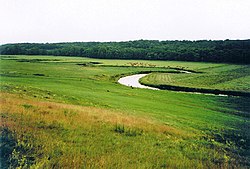Tollense
| Tollense | |
|---|---|
 | |
 | |
| Physical characteristics | |
| Source | |
| • location | Mecklenburg-Vorpommern |
| Mouth | |
• location | Peene |
| Length | 68 km (42 mi) |
The Tollense (German pronunciation: [tɔˈlɛnzə]) is a river in Mecklenburg-Vorpommern in northeastern Germany, right tributary of the Peene. The river starts as the outflow of the lake Tollensesee in Neubrandenburg. The Tollense is 68 km long and empties into the river Peene in Demmin. The rivers are part of the Mecklenburg Lake Plateau, with one of the largest areas of fens and about a thousand lakes, left over from the Ice Age.
Presumed Tollense battle site
As initially reported in the German media, human remains from the Bronze Age were found in the region named "Tollensetal" (Tollense valley) since 1997.[1] Many individuals showed signs of serious injury and violent death, leading to a hypothesis of some kind of inter-tribal conflict. Starting in 2008, archaeological study of the site zeroed in on an area of two square kilometers. Hundreds of bone fragments belonging to a very large number of persons have since been discovered along with further corroborating evidence of battle; current estimates indicate that perhaps 4000 warriors took place in a battle on the site. These findings were possible due to the preservation of the former fen (swamp) ground and the fact that the Tollense has never really changed its course. Since the population density then was about 5 people per square kilometer, this would have been the most significant battle in Bronze Age period Germany yet to be discovered. Moreover, the Tollense valley is so far the largest excavated battle site of this age anywhere in the world.[2] Further investigation of the site took place in the years 2010 to 2015.
There are a number of features that point to the Tollense's status as a battle site. Bronze weapons and armor as well as wooden weaponry and flint arrowheads have been found in abundance. Fractured skulls unearthed at the site suggest face-to-face combat, possibly between warring tribes.[3] All of the remains appear to be from young men, based on osteological analysis and preliminary genomic analysis, and many of the injuries seem to have occurred immediately before death. The bodies do not appear to have been buried in a normal ceremony and instead were dumped, or simply fell, in the river. Horse bones were also found at the site and a fractured thigh bone suggests a fall from a horse. Recent studies suggest that the fractured thigh bone was probably caused by a bronze spearhead rather than a fall from a horse.[4]
As of 2015, bodies of at least 130 human male individuals and 5 horses have been identified in an area of only 450 square meters; extrapolating from the excavated area, the entire battle area may contain bodies of 750 people. A rough estimate is that 4000 warriors took part in the battle. At the time of the battle, northern Europe is believed to have no towns and few small villages. Known archeological sites indicate local people lived with their extended families on farms, and the population density was less than five people per square kilometer. The nearest known large settlement was more than 350 kilometers to the southwest, in the historic Watenstedt district of current Salzgitter. Chemical tracers in the body remains indicate most of the Tollense warriors were from hundreds of kilometers away and ate millet, not grown in that part of the country at that time. Based on the difficulties of fighting in armor for novices, the warriors are inferred to have been professional fighters.[4]
See also
References
- ^ Massacre at the Tollense, Spiegel Online (German)
- ^ Neil Bowdler (22 May 2011). "Early Bronze Age battle site found on German river bank". BBC News. Retrieved 22 May 2011.
- ^ "A Bronze Age Battlefield? Weapons and Trauma in the Tollense Valley, north-eastern Germany". ResearchGate. doi:10.1017/S0003598X00067843. Retrieved 2016-03-27.
- ^ a b "Slaughter at the bridge: uncovering a colossal Bronze Age battle". www.sciencemag.org. Retrieved 2016-03-26.
